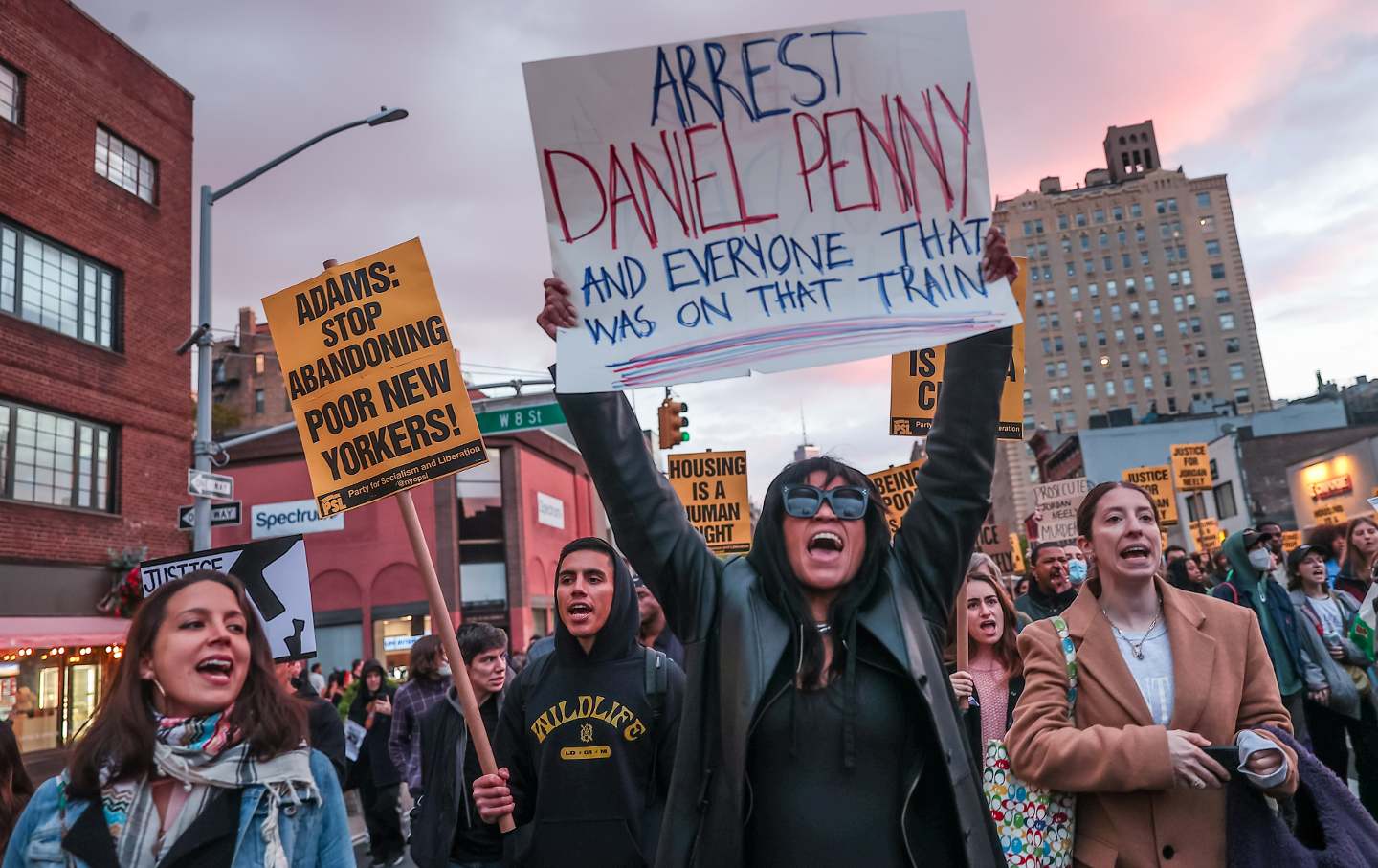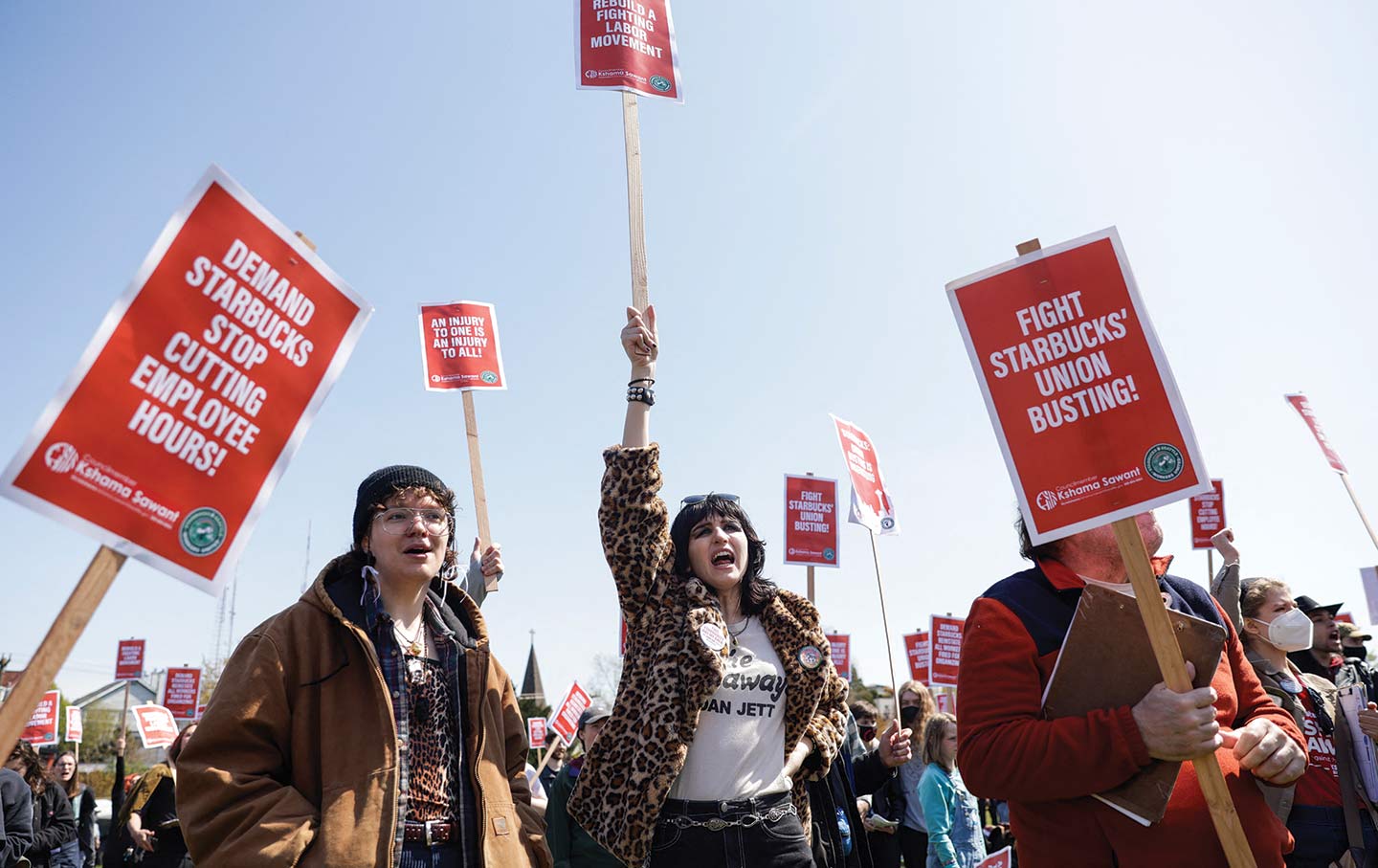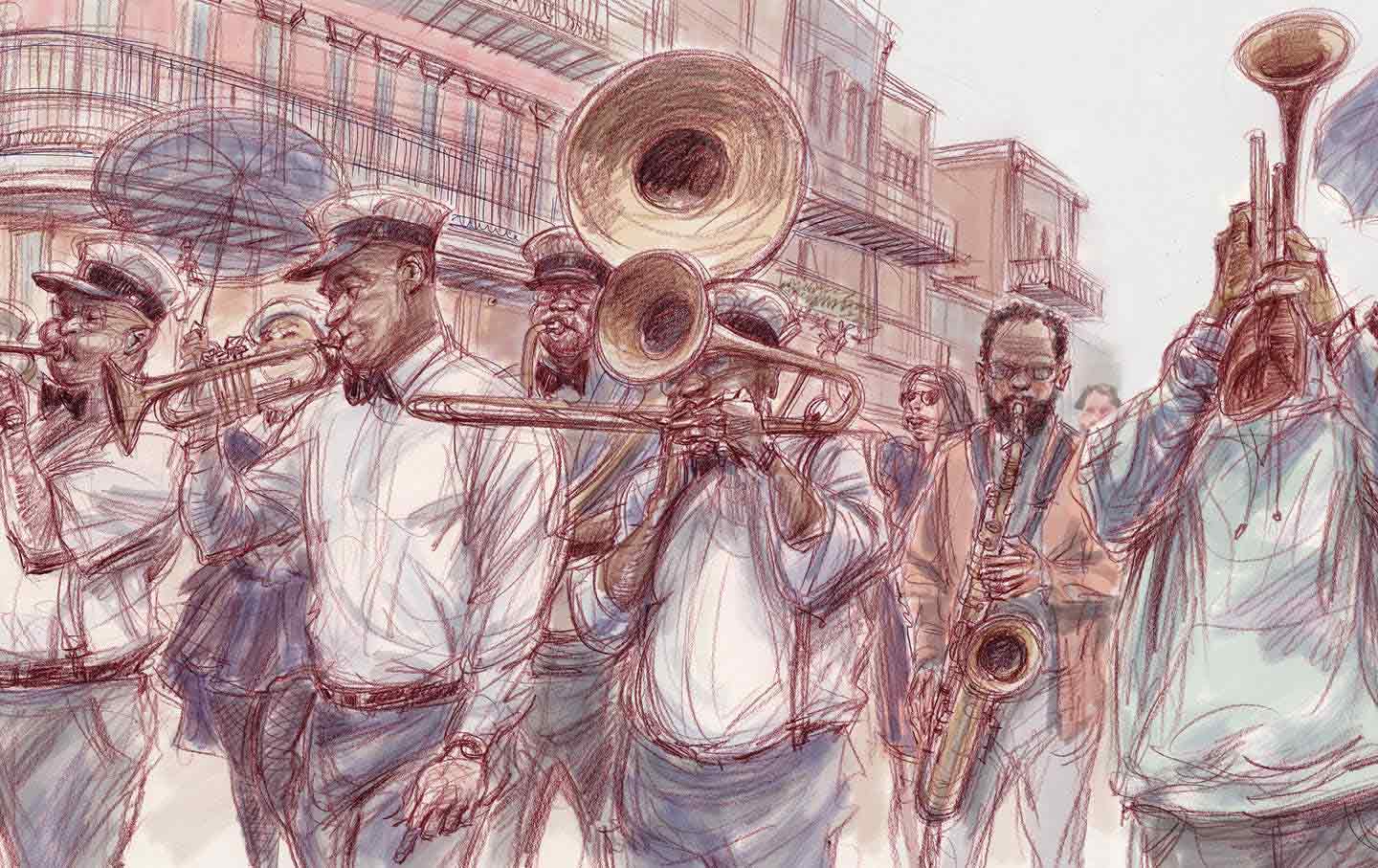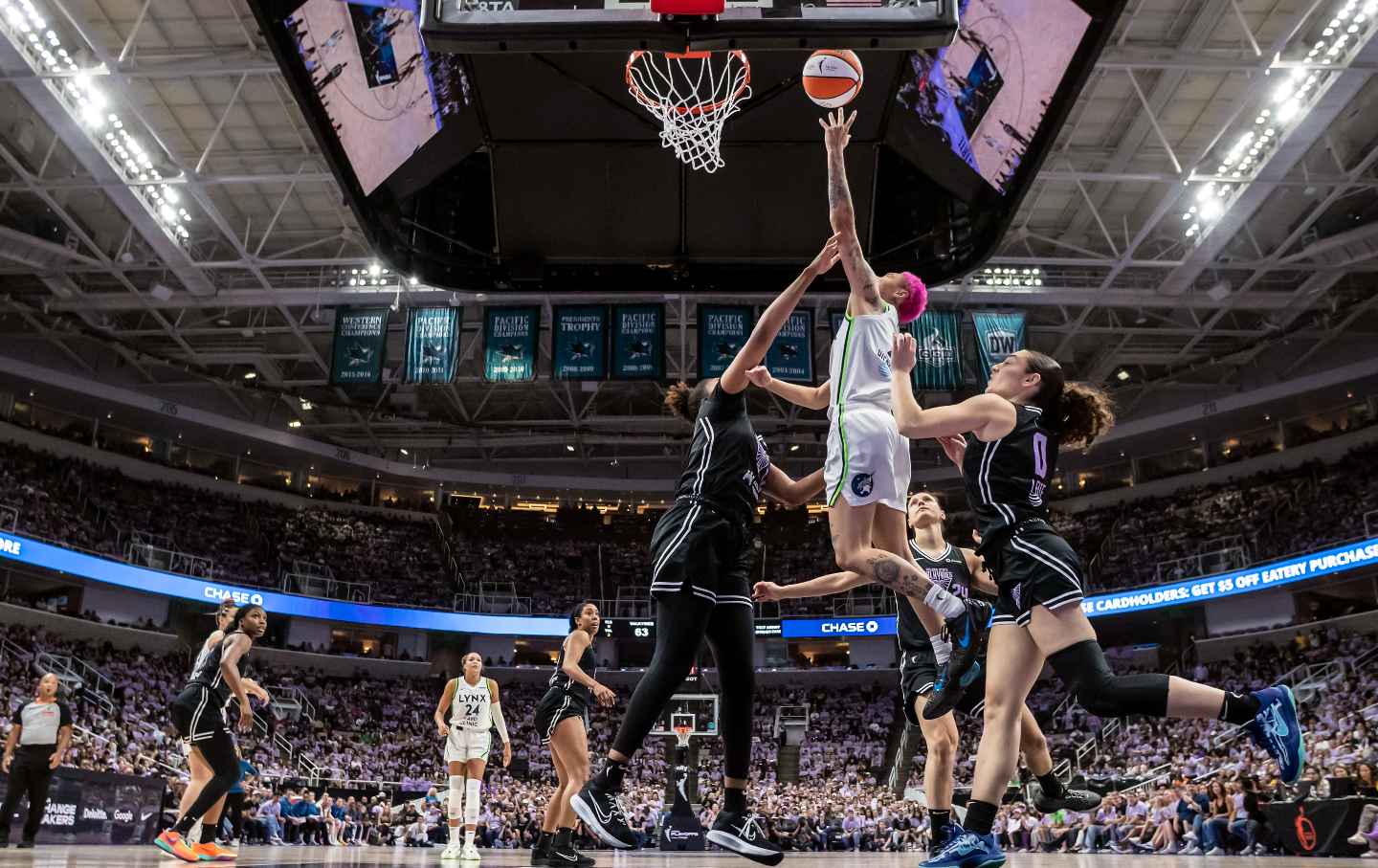Why the Right Is Winning Its War on Unhoused People
Americans’ attitude toward people sleeping on the street has become angrier, crueler, and more overtly violent. Blame a right-wing propaganda campaign.

Hundreds of demonstrators hold banners in Washington Square Park in New York City on May 5, 2023. Charges were called against the former US Marine who choked a homeless man, Jordan Neely, to death on the subway.
(Photo by Selcuk Acar / Anadolu Agency / Getty Images)Something has shifted in how policy-makers and the public view homelessness: Our posture toward unhoused people has become angrier, crueler, more overtly violent and rancorous. Over the past couple of years, people have become more willing to say and do things to unhoused people that they might once have shied away from. And the social and legal sanction they receive for these things is perfunctory, as if accompanied by a collective shrug. What were they supposed to do? I probably would have done the same.
The killing of Jordan Neely this spring and the subsequent valorization of his killer, Daniel Penny, who was recorded choking Neely to death on a crowded subway car, dramatized a process that has been playing out in subtler ways across the country. In San Francisco, a man was recorded attacking random unhoused people with bear spray. Another San Franciscan, expressing frustration with a spate of car robberies, told the San Francisco Chronicle that he wanted to burn down the encampment where the alleged carjacker lives. Nationwide, murders of unhoused people are climbing; every week, this country is producing more Daniel Pennys.
The spike in violence against unhoused people has been accompanied by crackdowns. San Diego recently became the latest big city to pass an encampment ban; police in Houston have been ticketing activists for the crime of giving food to unhoused people. And, earlier this month, the City of Sacramento admitted that it has continued to clear encampments in defiance of a court order.
There are a few reasons for this grim trajectory. One is simply that American homelessness is getting worse. It increased nearly 30 percent between 2005 and 2022, according to regional point-in-time counts (annual census-style surveys that aim to count the number of unhoused people in a region on a single day out of the year). More people who have never personally experienced homelessness are seeing encampments in their neighborhoods. They are understandably aggrieved; in too many cases, that aggrievement has curdled into something far uglier.
But the rise of state and vigilante attacks on unhoused people isn’t an inevitable reaction to metastasizing homelessness; it’s at least in part the byproduct of a successful propaganda campaign. For years, a network of right-wing demagogues has been depicting unhoused people as subhuman, parasitical, and intrinsically criminal.
Despite the fascist overtones in this message, they’ve been able to garner a sympathetic audience in the cultural mainstream. They’ve written opinion pieces in major newspapers; they’ve been profiled in glossy magazines and appeared on prime-time television; the Republican Party has embraced their ideas, and more than a few Democratic officials have nodded along. They’ve been winning the policy debate.
Disgust with unhoused people is at least as old as the modern American homelessness crisis, which emerged in the late 1970s and early 1980s as housing prices climbed and cities buckled under the long-term consequences of urban renewal. But the right’s recent efforts to capitalize on people’s revulsion of their unhoused neighbors are novel in their scope and intensity.
If any one person deserves credit for sensing the opportunity, it would have to be Christopher Rufo, a senior fellow at the Manhattan Institute. Though now best known for his crusades against “wokeness,” Rufo came to prominence as a pundit in Seattle, where he wrote a series of essays arguing that homelessness should be addressed through more aggressive policing, not more social services and housing subsidies. As he put it euphemistically in a 2021 Heritage Foundation report, homelessness is “a human problem, not a housing problem.”
As Rufo’s star rose, others joined in. Professional gadfly Michael Shellenberger, who had made his name through an association with the ecomodernism movement, took a hard pivot into urban policy with the 2021 book San Fransicko: Why Progressive Ruins Cities, which appropriated much of Rufo’s argument and extensively cited him. The message spread through other right-wing channels: the Cicero Institute, a think tank started by Palantir cofounder Joe Lonsdale; Rufo’s colleagues at the Manhattan Institute, most notably Heather MacDonald; PragerU, which coproduced a 23-minute video on homelessness with the Cicero Institute; and, of course, Fox News.
Characteristically, Tucker Carlson (then the top star at Fox) offered the clearest and most forthright account of the emerging reactionary consensus on homelessness. In a 2022 commentary on his show, Carlson described unhoused people as “the least productive, most antisocial parasites in our society.” He proposed the following solution to homelessness:
Stop putting up with it. Say no. No, you can’t smoke meth in the park. You’re not allowed to crap on the sidewalk. Pull up your pants and get the hell out of here.
Carlson stopped just short of calling for the violent eradication of unhoused people. A few months later, Fox News no longer felt the need to stop short; the network’s talent openly praised Daniel Penny for killing Jordan Neely. “This was not just reasonable behavior by Daniel Penny, but potentially heroic behavior by Daniel Penny,” said Will Cain, one of the weekend morning hosts, before adding, “Our society, to be absolutely clear, needs more Daniel Pennys.”
Why did Rufo and those who followed adopt homelessness as their pet issue? Partly because it was there: Widespread, visible homelessness in places like New York City, Seattle, and San Francisco was politically salient to the locals. And the right could plausibly argue that homelessness was especially prevalent in liberal cities because of progressive governance, not in spite of it.
But homelessness serves another purpose for the far right. Consider the other preoccupations of the San Fransicko crowd: Rufo went from fulminating against supportive housing programs to attacking diversity, equity, and inclusion initiatives; Shellenberger has diversified into assaults on “trans ideology.” Tucker Carlson is, well, Tucker Carlson. And then there’s Richard Hanania, another celebrity of the online right, whom HuffPost recently outed as an (allegedly former) white supremacist. Here’s what Hanania had to say after New York District Attorney Alvin Bragg charged Penny with manslaughter for killing Neely: “These people are animals, whether they’re harassing people in subways or walking around in suits.”
Bragg is Black, and so was Neely. Both are “animals” in Hanania’s view, but Neely in particular was deserving of extrajudicial execution.
Racism, homophobia, and transphobia aren’t incidental to the anti-homeless smear campaign; they’re part of the point. Disgust with unhoused people is a gateway into an entire politics built around the murderous contempt for subaltern groups. Conveniently, Black and queer people are disproportionately likely to experience homelessness in America; to reactionaries, homelessness becomes both a consequence of their subaltern status and an explanation for it.
Popular
“swipe left below to view more authors”Swipe →Thus homelessness plays a central, underestimated role in the authoritarian right’s recruitment efforts. Mainstream news outlets continue to promote the views of Rufo, Shellenberger, Lonsdale, and their comrades. Rufo still gets his op-eds placed in The New York Times. Hanania suffered a career setback thanks to the HuffPost scoop, but he continues to have friends in high places. Shellenberger is now one of the marquee names at Bari Weiss’s news startup, The Free Press.
But the real marker of the campaign’s success is not the career fortunes of its chief ideologues. We should instead judge the campaign’s success by its effect on public policy. By that measure, San Fransicko is probably one of the more effective books on policy published in the past few years. It’s a testament to the visceral power of the far right’s message. (It’s certainly not a testament to the strength of Shellenberger’s argument; San Fransicko is riddled with factual errors and sloppy reasoning, some of which I identified here.)
The recent uptick in encampment bans and sweeps has been accompanied by a retreat from real solutions to homelessness. The main policy target of the far right’s campaign has been Housing First, a strategy that prioritizes moving unhoused people into subsidized permanent housing, along with social services as needed. The overwhelming consensus among researchers is that Housing First works; cities like Houston and Helsinki have used the strategy to dramatically cut rates of homelessness. But Housing First works only because it assumes that the cure for homelessness begins with an offer of housing; to invert Rufo’s formula, it stipulates that homelessness is a housing problem, not a human problem.
And as with so many policies, implementation is everything. Doing Housing First correctly requires extensive interdepartmental coordination and communication; city agencies, county offices, and nonprofit service providers all need to be working in the same direction. Perhaps most importantly, Housing First needs housing. Helsinki could rely on its extensive stock of social-housing units; Houston’s loose land-use rules meant the private market could generate a large supply of naturally affordable units. In places where housing is scarce, no amount of good intentions will generate the physical infrastructure necessary to make Housing First workable on a large scale.
California tried. Over the past five years, the state has allocated $20.6 billion to funding housing and homelessness programs, including $5 billion to local and regional agencies for fighting homelessness and $3.7 billion for Homekey, a program that creates homeless housing by converting motels, hotels, and residential properties. Meanwhile, cities like San Francisco and Los Angeles identified their own new funding streams for addressing homelessness.
And yet. Despite all that spending, California’s point-in-time homelessness counts recorded a 24 percent increase between 2018 and 2022.
There are several reasons California’s $20 billion investment did not lead to the desired result, most of them having to do with the state’s housing shortage. Persistently high rents continue to push Californians into homelessness faster than the state can rehouse them; meanwhile, the same land-use rules that constrain housing supply and push those rents to dizzying heights also drive up development costs and slow down the state’s efforts to build more housing for unhoused residents. The state’s billions could not go far enough or fast enough to stem the tide.
While California’s failure was the product of a broken housing market and limited state capacity, it looked from the outside like a failure of the Housing First strategy itself. The right used this to its advantage, going so far as to claim that supportive housing development encouraged homelessness by providing layabouts with cushy free apartments. Housing First “appears to attract more people from outside the homeless system, or keeps them in the homelessness system, because they are drawn to the promise of a permanent and usually rent-free room,” according to one Cicero Institute memo.
The gap between the state’s ambitions and what Californians saw firsthand seemed to support their argument.
Thus far, the response to the far right from Team Housing First has been muted. When San Fransicko was released, multiple homeless service providers and advocates told me that we shouldn’t respond to Shellenberger because it would only drive more media coverage of his obviously bogus arguments. As the weeks and months wore on, it became clear that he didn’t need our help generating media interest, but many prominent Housing Firsters remained strenuously committed to avoiding direct confrontation.
With the benefit of hindsight, we can say definitively that nonconfrontation has failed. Instead of starving reactionaries of media attention, it allowed them to lie with impunity.
It’s time to go on the offensive. Instead of trying to ignore prominent reactionaries, advocates for unhoused people should review what they publish and say publicly; identify false or misleading utterances; and write reports, op-eds and blog posts that fact-check them. Make sure the journalists who cover this issue are aware of every falsehood. Because in the absence of any concerted pushback, even nominally progressive publications will accept some of the right’s claims about homelessness at face value; HuffPost, for example, once ran a flattering profile of Shellenberger, describing him as a moderate with a “brainy style and preference for policy discussion.” That piece might have turned out differently if advocates for the unhoused had been less diffident.
More on Homelessness
Second, advocates need to better acknowledge the anger felt by many residents of high-homelessness areas. Living near large concentrations of extreme poverty is unpleasant, and it can in some cases be unsafe. People have a right to be frustrated; the far right will have a significant advantage so long as it can claim that only it shares that frustration. Even worse, the far right’s proposed “solution”—dispersing encampments and rounding up their occupants—is more straightforward, despite its cruelty and its ineffectiveness. The only way to counter that advantage is by making disgruntled residents feel heard.
Third, advocates need to confront the reasons large investments in Housing First infrastructure haven’t led to corresponding declines in homelessness. A strategy based on requesting greater levels of public investment without delivering tangible results is doomed. A better approach would focus on securing those investments and fixing the broken housing policies that hinder their effectiveness. That’s one reason I moved from working in homelessness policy to a role at California YIMBY (“Yes in My Backyard”), an organization dedicated to relieving California’s housing shortage. YIMBYs and homeless nonprofits often work in silos, but they share a common mission. Just as YIMBYs should fight for Housing First, Housing Firsters should fight to make housing cheaper and more abundant.
Despite the noxious political climate and the successes of reactionary grifters, the homelessness crisis remains solvable. But the longer the crisis goes on, the more it will empower opportunists who will make things even worse. They’ve already made solving homelessness considerably harder by promulgating punitive, and even eliminationist ideas about what to do with unhoused people. If we’re going to build the political support to actually get people into housing, those ideas cannot be allowed to spread unchallenged. We need to confront them head-on.
Disobey authoritarians, support The Nation
Over the past year you’ve read Nation writers like Elie Mystal, Kaveh Akbar, John Nichols, Joan Walsh, Bryce Covert, Dave Zirin, Jeet Heer, Michael T. Klare, Katha Pollitt, Amy Littlefield, Gregg Gonsalves, and Sasha Abramsky take on the Trump family’s corruption, set the record straight about Robert F. Kennedy Jr.’s catastrophic Make America Healthy Again movement, survey the fallout and human cost of the DOGE wrecking ball, anticipate the Supreme Court’s dangerous antidemocratic rulings, and amplify successful tactics of resistance on the streets and in Congress.
We publish these stories because when members of our communities are being abducted, household debt is climbing, and AI data centers are causing water and electricity shortages, we have a duty as journalists to do all we can to inform the public.
In 2026, our aim is to do more than ever before—but we need your support to make that happen.
Through December 31, a generous donor will match all donations up to $75,000. That means that your contribution will be doubled, dollar for dollar. If we hit the full match, we’ll be starting 2026 with $150,000 to invest in the stories that impact real people’s lives—the kinds of stories that billionaire-owned, corporate-backed outlets aren’t covering.
With your support, our team will publish major stories that the president and his allies won’t want you to read. We’ll cover the emerging military-tech industrial complex and matters of war, peace, and surveillance, as well as the affordability crisis, hunger, housing, healthcare, the environment, attacks on reproductive rights, and much more. At the same time, we’ll imagine alternatives to Trumpian rule and uplift efforts to create a better world, here and now.
While your gift has twice the impact, I’m asking you to support The Nation with a donation today. You’ll empower the journalists, editors, and fact-checkers best equipped to hold this authoritarian administration to account.
I hope you won’t miss this moment—donate to The Nation today.
Onward,
Katrina vanden Heuvel
Editor and publisher, The Nation
More from The Nation

Organized Labor at a Crossroads Organized Labor at a Crossroads
How can unions adapt to a new landscape of work?

The Epstein Survivors Are Demanding Accountability Now The Epstein Survivors Are Demanding Accountability Now
The passage of the Epstein Files Transparency Act is a big step—but its champions are keeping the pressure on.

The Fight to Keep New Orleans From Becoming “Everywhere Else” The Fight to Keep New Orleans From Becoming “Everywhere Else”
Twenty years after Katrina, the cultural workers who kept New Orleans alive are demanding not to be pushed aside.

Breaking the LAPD’s Choke Hold Breaking the LAPD’s Choke Hold
How the late-20th-century battles over race and policing in Los Angeles foreshadowed the Trump era.

Mayor of LA to America: “Beware!” Mayor of LA to America: “Beware!”
Trump has made Los Angeles a testing ground for military intervention on our streets. Mayor Karen Bass says her city has become an example for how to fight back.

The WNBA Makes More Money Than Ever. What About the Players? The WNBA Makes More Money Than Ever. What About the Players?
WNBA players receive around 10 percent of league revenue compared to the NBA’s 51 percent. With their bargaining agreement expiring in January, players want to share in the growth...


